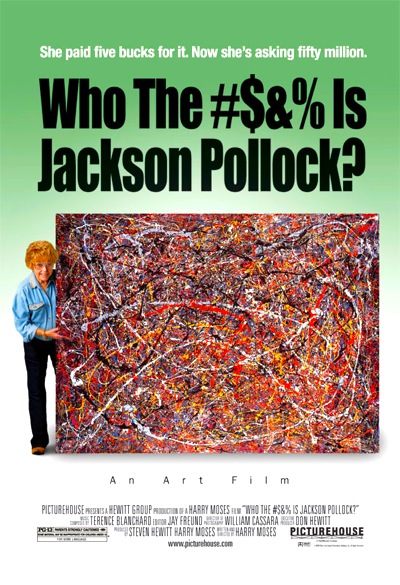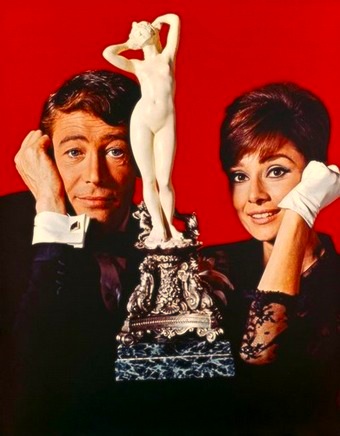 By David Ross. Who the #$&% Is Jackson Pollock? (2006) is a lively little documentary about Teri Horton, a feisty, gravel-voiced grandma who embodies every red state stereotype. She purchased a large drip painting for $5 in a thrift shop in San Bernardino. Somebody naturally mentioned Jackson Pollock, of whom she had never heard, and she took it into her head that she’d purchased a lost masterpiece worth tens of millions. There ensued an epic battle as Horton pestered the skeptical and obnoxiously condescending mandarins of the art world, demanding the canonization of her painting. The whole business might have been filed under the heading “crank makes a pest of herself,” except that Horton had an ace up her sleeve: the forensic art expert Peter Paul Biro claimed to have found a fingerprint on Horton’s painting that matched a fingerprint he had lifted from Pollock’s studio. At this point the controversy becomes fascinating, as it pitches curatorial instinct against forensic evidence and raises basic questions about art authentication and even more basic questions about epistemology. The film, of course, is interested in none of this, at least not in a serious way; it unhesitatingly sides with the feisty granny against the insufferable Ivy League boors, liking the entertainment value of its own populist narrative.
By David Ross. Who the #$&% Is Jackson Pollock? (2006) is a lively little documentary about Teri Horton, a feisty, gravel-voiced grandma who embodies every red state stereotype. She purchased a large drip painting for $5 in a thrift shop in San Bernardino. Somebody naturally mentioned Jackson Pollock, of whom she had never heard, and she took it into her head that she’d purchased a lost masterpiece worth tens of millions. There ensued an epic battle as Horton pestered the skeptical and obnoxiously condescending mandarins of the art world, demanding the canonization of her painting. The whole business might have been filed under the heading “crank makes a pest of herself,” except that Horton had an ace up her sleeve: the forensic art expert Peter Paul Biro claimed to have found a fingerprint on Horton’s painting that matched a fingerprint he had lifted from Pollock’s studio. At this point the controversy becomes fascinating, as it pitches curatorial instinct against forensic evidence and raises basic questions about art authentication and even more basic questions about epistemology. The film, of course, is interested in none of this, at least not in a serious way; it unhesitatingly sides with the feisty granny against the insufferable Ivy League boors, liking the entertainment value of its own populist narrative.
Having watched the film and weighed its evidence, I was torn and confused. A fingerprint is a fingerprint. On the other hand, I’ve spent time among collectors, curators, and scholars, and I know that the aesthetic eye is not a myth; what seem like snap or arbitrary judgments are a matter of the brain instantly acting on tens of thousands of hours of looking and thinking and comparing. There really are experts in this sense. Thomas Hoving, a former director of the Metropolitan Museum, is an example. He appears in the film as the chief witness for the prosecution, calling Horton’s painting laughable and ridiculing Horton’s right even to hold an opinion on the matter, in what must be one of the most uninhibited displays of pomposity ever captured on film. But Hoving’s personality does not, as the film seems to insinuate, invalidate his judgment. Nobody should doubt that a director of the Met knows incalculably more than a former truck driver, and that this knowledge is substantive and meaningful.

Like Hoving, I had the sense that the painting was off. I am not an expert on Pollock, but I know what one is supposed to feel in the presence of a great painter’s work – a certain flood of beauty and meaning, a sense of intricacy too great to be immediately digested. I was feeling none of it. The painting seemed to lack drama, presence, rhythm. It occurred to me that if the painting struck my dull eye as dubious, it must be very dubious indeed. Could the painting have been authentic, but for some reason botched? Could Pollock’s seminal energies have been dammed by a migraine or a hangover or a tiff with the wife? Perhaps he knew the painting stunk and dispatched it to the dump or gave it to the milkman. This would explain why the painting is unsigned, and begins to explain how it wound up in a thrift store in San Bernardino. In sum, I didn’t know what to think.
The New Yorker has thankfully rescued me from my uncomfortable cognitive dissonance. In a superb piece of investigative reporting (see here), David Grann brought a different kind of skepticism to the controversy, assailing the fingerprint evidence and finding plenty in Biro’s past to raise the possibility that he is an outright charlatan. The article does not merely supplement the film, but supersedes it entirely. Skip the film – read the article.
Those who enjoy the whodunit aspect of art authentication should have a look at Hoving’s False Impressions: The Hunt for Big-Time Art Fakes (1997). Hoving’s brashness plays better on the page than it does on film, lending a humorous derision to his many anecdotes of stupidity, arrogance, and low cunning. The book is a very useful prophylactic; anybody who reads it will be cured of the fantasy of the lost masterpiece. You can take it for granted that the thing’s a fake.

While on the subject of art authentication, let me note the documentary F for Fake (1973), Orson Welles’ last and least celebrated directorial effort, and by far the strangest and most problematic of his films. It is a postmodern phantasmagoria on the theme of fakery, centered – precariously – on the activities of the Elmyr de Hory (see here), one of the premier art forgers of twentieth century, and his equally shady biographer Clifford Irving, author of a fraudulent autobiography of Howard Hughes (see here). Elmyr is a whirl of joie de vivre as he whips up Matisses and airs his laissez-faire philosophy (“I don’t feel bad for Modigliani – I feel good for me”), but the interesting question is why Welles felt drawn to his subject matter. Does the great director conceive the great forger as a fellow illusionist or as an object lesson in the temptation of shortcuts, partial mastery, pastiche? Or is the motive ironic – a commentary on the world’s tendency to muff the distinction between true art and fake art, with the implication that Welles himself has been the victim of this incompetence? Students of Welles will find much to consider in this barmy, brilliant experiment in documentary, as well as much to enjoy: particularly a lascivious segment that provides more than an eyeful of Oja Kodar, Welles’ lover for the last twenty-four years of his life and a woman clearly born to be a Bond girl.
Finally, let us not forget William Wyler’s How to Steal a Million (1966), starring Peter O’Toole and Audrey Hepburn, a heist/forgery flick that has the distinction of being the least gritty crime film ever made. If any film is made of spun-sugar and Givenchy finery, this is it. It includes several charming witticisms on the subject of forgery:
Charles Bonnet: Don’t you know that in his lifetime Van Gogh only sold one painting? While I, in loving memory of his tragic genius, have already sold two.
And:
Charles Bonnet: I doubt very much if Van Gogh himself would have gone through so much trouble.
Nicole Bonnet: He didn’t have to. He was Van Gogh!
And:
Charles Bonnet: What have I done? I’ve given the world a precious opportunity of studying and viewing the Cellini Venus.
Nicole Bonnet: Which is not by Cellini!
Charles Bonnet: Ahh, labels, labels. It’s working with the Americans that’s given you this obsession with labels and brand names.
It’s interesting that all of these films and books slip into a kind of merriment. Forgery, it seems, is very close to comedy and the carnivalesque. It makes asses of those in authority, jumbles categories, upends assumptions. The forger is very much like the court jester or the Shakesperean fool, and even those like Hoving, who have millions of dollars at stake, cannot help but smile.
Posted on August 17th, 2010 at 10:36am.
For God’s sake, correct the misspelling of Peter O’Toole’s name. Other than that, great piece. In the same vein, you have to see “Exit Through the Gift Shop,” which takes a similarly wry take on the graffiti/street art scene and the phoniness attached to it. Great documentary.
Yes, that misspelling was a bit unfortunate – and was my fault, not David’s.
I know what one is supposed to feel in the presence of a great painter’s work – a certain flood of beauty and meaning, a sense of intricacy too great to be immediately digested. I was feeling none of it.
One wonders how much of that feeling arises from the prior knowledge that the object was in fact produced by a great painter. As for the lack of such feeling in this case, could it have been influenced by an understandable desire not to appear the fool by extolling the virtues of a possible fake?
A reasonable theory, but in this case inapplicable. Because of the fingerprint evidence, I assumed that Teri Horton’s painting was genuine, and I could not understand why it seemed so flat and stale.
FWIW, F For Fake is on Netflix Instant Watch (and has been sitting in my queue for months now).